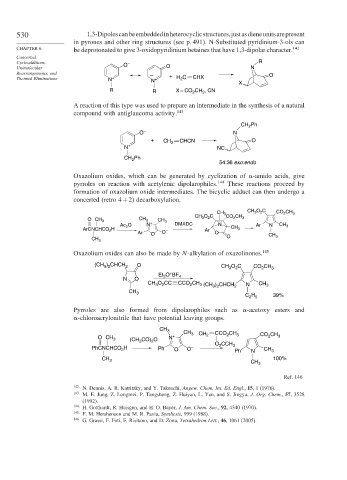Page 556 - Advanced Organic Chemistry Part B - Reactions & Synthesis
P. 556
530 1,3-Dipolescanbeembeddedinheterocyclicstructures,justasdieneunitsarepresent
in pyrones and other ring structures (see p. 491). N-Substituted pyridinium-3-ols can
CHAPTER 6 be deprotonated to give 3-oxidopyridinium betaines that have 1,3-dipolar character. 142
Concerted
Cycloadditions, O – R
Unimolecular O N
Rearrangements, and – O
Thermal Eliminations N + N + + H 2 C CHX X
R R X = CO CH , CN
2
3
A reaction of this type was used to prepare an intermediate in the synthesis of a natural
compound with antiglaucoma activity. 143
CH Ph
2
O – N
+ CH 2 CHCN O
N + NC
CH Ph
2
54:36 exo:endo
Oxazolium oxides, which can be generated by cyclization of -amido acids, give
pyrroles on reaction with acetylenic dipolarophiles. 144 These reactions proceed by
formation of oxazolium oxide intermediates. The bicyclic adduct can then undergo a
concerted (retro 4+2) decarboxylation.
CH 3 O 2 C
CH 3 CO 2 CH 3
CH 3 O 2 C CO 2 CH 3
O CH 3 CH 3 CH 3
Ac 2 O N + DMADC N Ar N CH 3
ArCNCHCO 2 H Ar CH 3
Ar O O – O
O CH 3
CH 3
Oxazolium oxides can also be made by N-alkylation of oxazolinones. 145
(CH ) CHCH 2 O CH O C CO CH 3
3 2
2
3
2
+
Et O BF 4
3
N O
CH O CC CCO CH 3 (CH ) CHCH 2 N CH 3
3
2
2
3 2
CH 3
H
C 2 5 39%
Pyrroles are also formed from dipolarophiles such as -acetoxy esters and
-chloroacrylonitrile that have potential leaving groups.
CH 3 CH CCO CH
2
O CH 3 (CH CO) O N + 3 CH 2 2 3 CO CH 3
2
3
O CCH 3
2
PhCNCHCO H Ph O O – Ph N CH 3
2
100%
CH 3
CH 3
Ref. 146
142 N. Dennis, A. R. Katritzky, and Y. Takeuchi, Angew. Chem. Int. Ed. Engl., 15, 1 (1976).
143
M. E. Jung, Z. Longmei, P. Tangsheng, Z. Huiyan, L. Yan, and S. Jingyu, J. Org. Chem., 57, 3528
(1992).
144 H. Gotthardt, R. Huisgen, and H. O. Bayer, J. Am. Chem. Soc., 92, 4340 (1970).
145 F. M. Hershenson and M. R. Pavia, Synthesis, 999 (1988).
146
G. Grassi, F. Foti, F. Risitano, and D. Zona, Tetrahedron Lett., 46, 1061 (2005).

